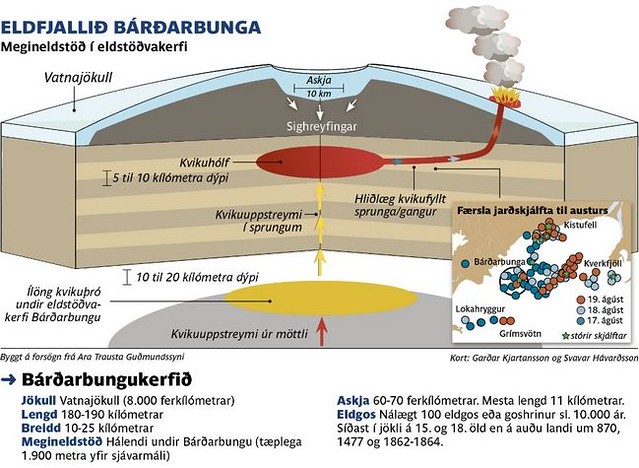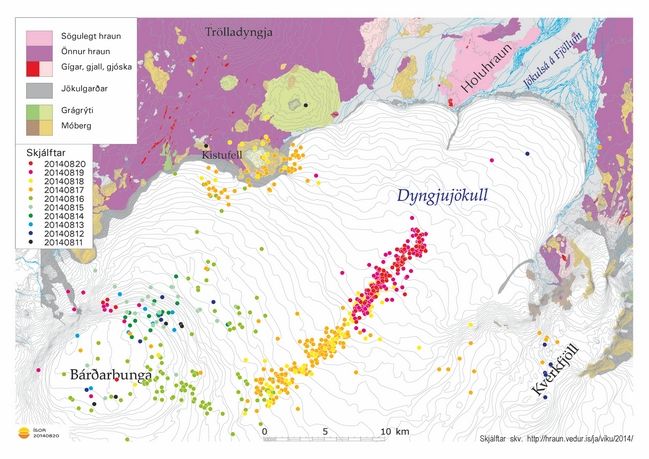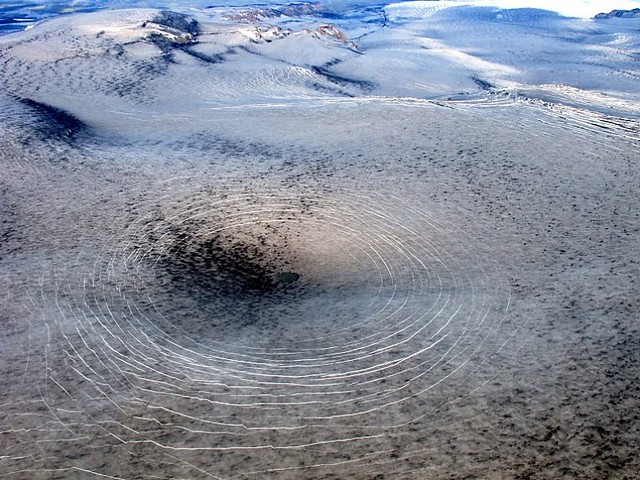This is part three of Eldfjallavakt, where we've been monitoring the serious situation in Iceland's largest volcanic system, Bárðarbunga
Picture the flow rate of a large (150-200 m³/s) river - say, 3x the rate of the Thames at London, or 1/3rd the rate of the Hudson at New York City. Now picture it comprised of an explosive variety of very gassy magma, 5-10 kilometers underground. Now picture that it has nowhere to go, yet it's still flowing at that rate via plowing through solid rock by creating an earthquake every two minutes. And picture that it's doing this before having any sort of pressure release to help the process along. On a rift system that's caused regular eruptions that have released so much gas and altered the climate so much that they've frozen the Mississippi River at New Orleans and the Tigris and Euphrates rivers in Iraq.
This is what's currently going on under Bárðarbunga, and is why we're watching it. More after the fold.
Let's start with a picture to help clear up what's going on before we get into the latest data and news:

The crust is largely solid. The mantle is hot enough to easily melt rock at the sort of pressures found in the crust, but is under so much pressure that it remains a (slowly flowing) solid. However, in the crust where you get the right combination of high heat at low pressures, rock melts and forms magma. Iceland is for reasons not yet fully understood abnormally proficient at this, far more than the rest of the Mid-Atlantic ridge, and is estimated to have produced 1/3rd of all lava on Earth in the past 500 years.
These tremendous deep magma chambers are separated from the surface by dozens of kilometers. From there, magma seeps through cracks in the rock to smaller magma chambers closer to the surface. These often form interconnected systems that interact with each other to varying degrees; an eruption in one part can trigger or suppress eruptions in other parts. But before an eruption can occur, magma must find its way to the surface via breaking a conduit through the rock. Beyond the usual, in Iceland, a relatively rare type of eruption sometimes occurs: a fissure eruption. In this case, magma chambers are elongated along a fissure, the conduits tend to track the fissure, and multiple vents can open up along the fissure and last or months or even years. Fissure eruptions have caused most of Iceland's devastating, world-affecting eruptions.
Five days ago, a massive earthquake swarm commenced in Bárðarbunga, involving more than an order of magnitude more earthquakes than led to the nearby Gjálp eruption in 1996. Volcanogists have been struggling in the Icelandic press to come up with proper superlatives to describe how much magma is on the move here, but I think this article does it best. 60 to 90 million cubic meters of magma has seeped up from the depths into the upper levels and plowed out a 25 kilometer-long conduit 5-10 kilometers underground in the past five days, tracking along the rift, at the volumetric flow rate of a major river. The flow speed (5 kilometers per day) is far lower than a river, but it makes up for this in the sheer size of the flow. The quantity that's moved in five days - still constrained by the rock above it - is more than the 1970s Heimaey eruption released in its entire 5 month eruption.
In the image below, earthquakes show the creation of the magma conduit along the rift:

As it stands, it's not moving any closer to the surface - it's just moving, relentlessly, in incredible volume. Geologists still do not know whether she will erupt. They are gathering as much data as they can, and today took radar images of the whole glacier to help monitor height changes better than their simple GPS meters. If the magma does start to come up to the surface, it will happen very quickly. The first sign visible on the surface would be a "sigkatli", a subsidence depression in the ice over the magma release point from the melting ice, while the surrounding ice will rise due to the increased pressure.

When the water breaks out, it creates a jökulhlaup, a volcanic outburst glacial flood. Bárðarbunga has previously released jökulhlaup of biblical proportions, including ones that carved this, mainly in a matter of days. Fortunately, due to the location and direction of travel of the magma conduit, this jökulhlaup is expected to be smaller, only 5000-10000 cubic meters per second. Unfortunately, all of the bridges connecting northern and northeastern Iceland are only designed to withstand 3000 cubic meters per second, and the transportation office has prepared equipment to quickly detach the roadbed from the columns to reduce the stress on them (losing only the roadbed). The loss is estimated to be $20-30 million dollars (but keep in mind, our economy is 1/1000th the size of the US's, so these sort of figures are much more significant). There's talk about the (quite real) possibility that the flood will completely eliminate the popular fishing lake Skjálftavatn, connecting it to the sea and draining it.
Approximately 10% of Iceland is now a closed zone, banned to all pedestrian and vehicle traffic without special permission. Last night the police and rescue services went to all campsites in the area and evacuated the people there. Today they had a plane look out for stragglers. The flood is expected to have even more significant affects further north, in the heavily trafficked Dettifoss/Ásbyrgi area, but by and large it hasn't been closed. The reason is that it will take six hours for the waters to reach there, and they believe that they can effectively evacuate the area in that time frame. However, one trail in the area has been closed because it's known to be out of cellular range and this is considered to pose too great of a risk in terms of ability to warm hikers. The closures and concerns of being stranded are already starting to damage our tourism industry.

We hope that the unprecidented level of activity will die down and the magma influx will stop. Unfortunately, just the opposite has happened. Just before noon, activity rose, with as many quakes over magnitude 2 in three hours than in the previous 20 hours. While it's dropped back down a bit since, the overall rate seems to be higher than before. But the magma still not going up, just moving further down the rift to the northeast.
Most people here seem to think the eruption is inevitable. The government is talking and behaving as if it is. I don't know whether it is or not. But if it does erupt, what will happen?
That, too, nobody knows.
Even with a large, very powerful system like Bárðarbunga, smaller eruptions are more common than big ones. The ideal is that there's a small volcano that releases just enough pressure that the system can die down and stop. The worst is one of Iceland's catastrophic eruptions that occur at about 100-200 year intervals. We not only don't know right now, but we won't know after it erupts, either, how it will play out. For the classic example, Laki's 1783-1784 eruption began with an eruption of Grímsvötn in early 1783, Laki began a small eruption in the summer, died down in July, but then at the very end of July suddenly unzipped along a fault line dozens of kilometers long and erupted suchly for 8 months.
Air travel disruptions? We don't know that either, but Icelandic air traffic control thinks they might even be worse than with Eyjafjallajökull. The technology for ash monitoring is improved, but risks are still not allowed in ash areas, and the volcanic system is much more massive. How the ash quality, quantity, and wind patterns will play out is still a complete unknown. I work in the air traffic industry, and I and my coworkers are all expecting to be put on-call 24/7 if the volcano erupts.
I hope my updates on this aren't tedious in that I can't state what is going to happen; I can only cover what data comes in and what the scientists are saying. But I'm most defininitely following this in detail, and given that this volcano has the potential to affect the whole northern hemisphere (and has in the not-too-distant past has done so regularly), I figured at least some of you might want to keep informed as well.
I'll post updates as the news comes in.


